Roasting Bone in Rib of Beef
Standing Rib Roast is considered by many to be the best roast beef in the world. Also known as Prime Rib, it's a beef cut that's incredibly succulent with superior taste. This recipe uses asafe, simple but highly effective roasting method so the beef is blushing pink all the way through.
Top tip? Pull the beef out before the target internal temperature as the meat continues to cook as it rests, taking medium rare beef to medium. Otherwise, it overcooks while resting!
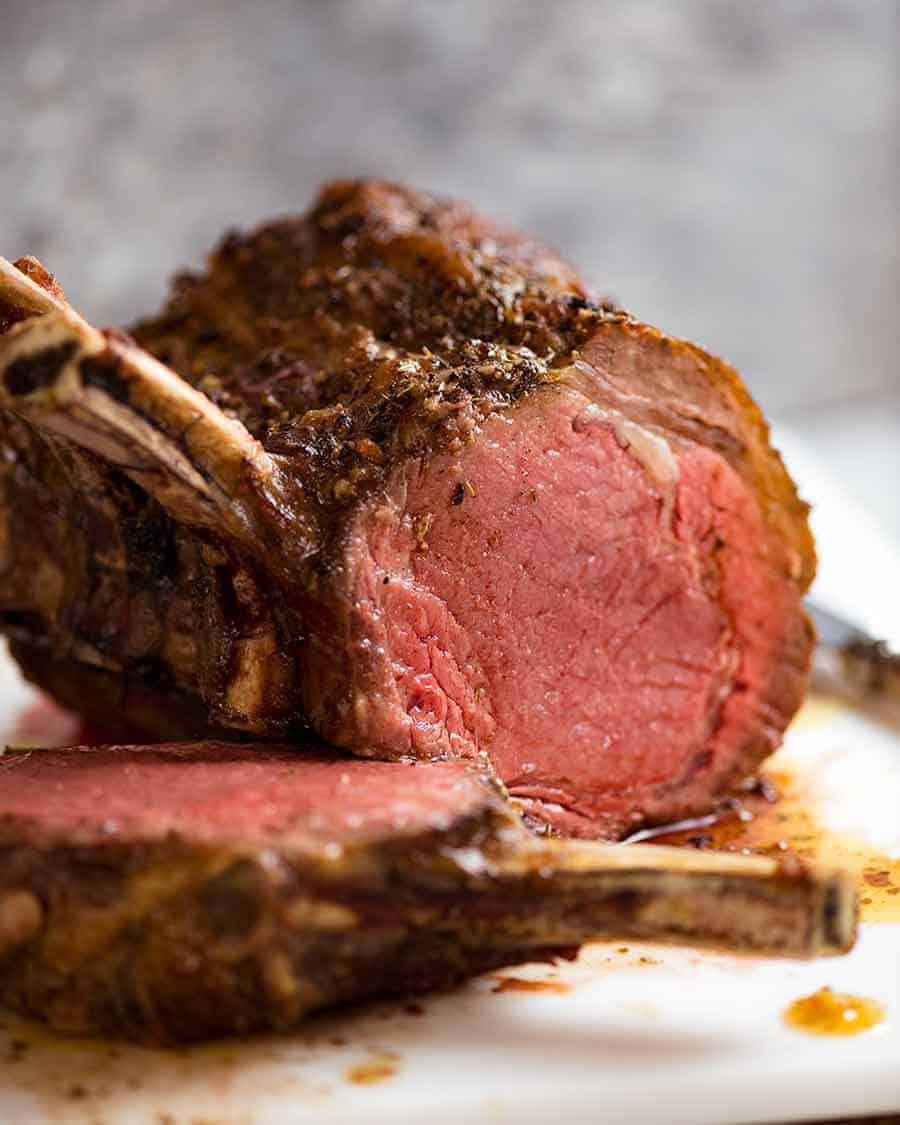
Standing Rib Roast – don't make this mistake!
The biggest mistake people make with prime rib is not factoring in that beef continues to cook as it rests. So if you pull it out of the oven at 52°C / 125°F, the target temperature for medium rare, it will rise to 55°C / 130°F or more once rested which is medium. Ie not much blushing pink left!
So you must pull the beef out of the oven before your Target Temperature. Here is a table of the internal temperature of Prime Rib for varying levels of doneness.
Internal temperature of cooked prime rib
The internal temperature of prime rib will rise by around 4°C / 5 – 7°F while resting, so it needs to be pulled out of the oven before reaching the Target Internal Temperature for your desired level of doneness.
| Doneness | Pull temperature | Target Temp after rest |
|---|---|---|
| Rare | 48°C/118°F | 51°C/124°F |
| Medium rare (recommended) | 50°C / 122°F | 54°C / 129°F |
| Medium | 53°C/127°F | 57°C / 135°F |
| Medium well done | 55°C/131°F | 59°C/138°F |
| Well done | Never! | n/a |
-
Target Temperature after resting – this is the internal temperature for each level of doneness, after resting.
-
Pull Temperature – this is the target internal temperature when you take it out of the oven, and it is lower than the Target Temperature to achieve the level of doneness you desire. The temperature rises when the beef is resting. If you take the beef out of the oven at the Target Temp, then by the time the beef has rested it will be beyond what you wanted.
Prime Rib – simply the best
There's no question – the Standing Rib Roast is the creme de la creme of roasts. Also known as Prime Rib, this is THE roast beef with superior flavour, texture and juiciness above all other cuts of beef.
It's certainly not an economical cut. It's an investment worthy of special occasions when gathering with like minded people who will appreciate that moment when you slice through the deep golden, garlic studded crust, those people in your life who will clap their hands with glee at the sight of the rose pink flesh, knowing that it's going to taste as incredibly juicy as it looks…..
Prepare yourself for the ultimate roast beef experience – complete with a gorgeous Red Wine Sauce, a side of Parish Mash and Garlic Sautéed Spinach!!
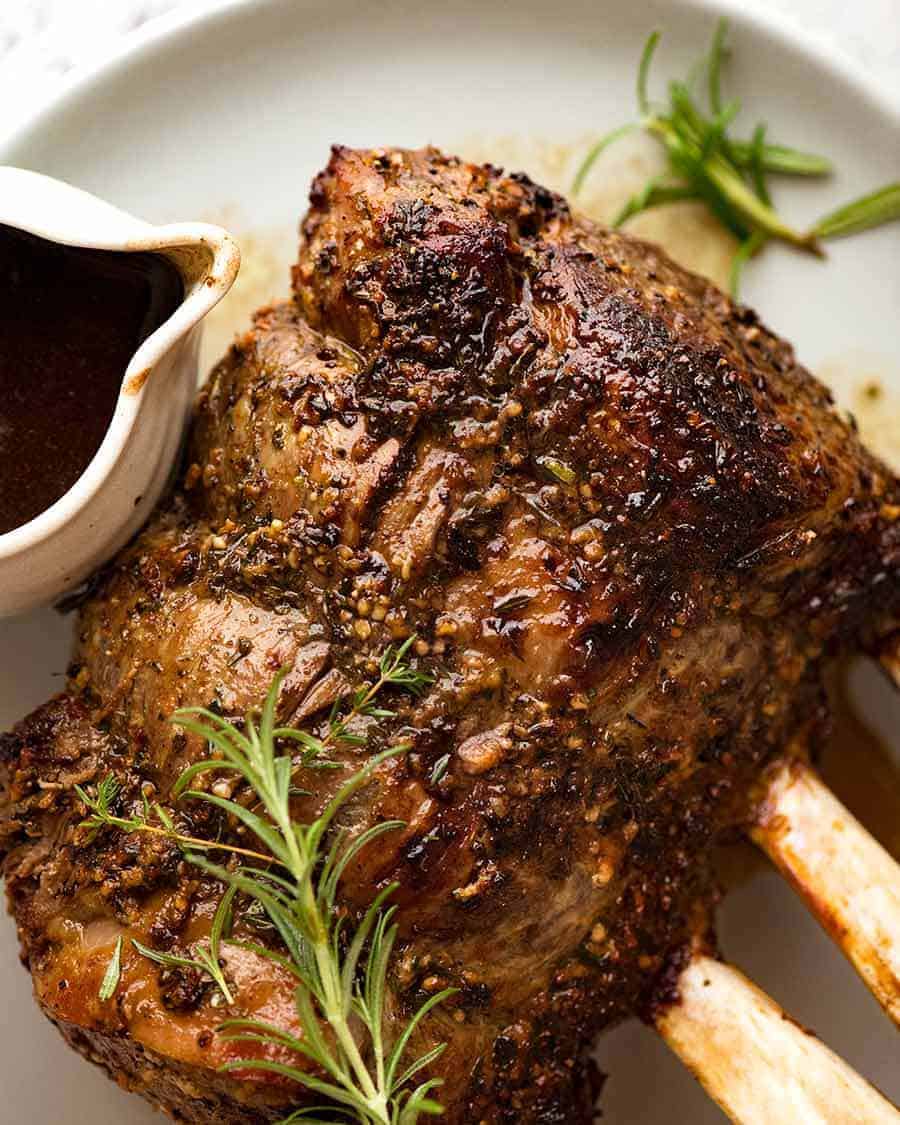
Safe, highly effective cooking method
A quick blast in a hot oven for 20 minutes, then 1.5 hours at a lower temperature. This yields a roast that's evenly cooked all throughout to the doneness of your choice (medium rare for me!), with a deep golden crust.
This method is safe and highly effective, with the benefits of a long slow cook but far quicker to make.
Roasting at a lower temperature isbetter than a Hard & Fast quick roast because it cooks more evenly throughout (no overcooked outer ring!), there's less risk of overcooking and the fat will melt to make the meat even juicier.
How to choose the best standing rib roast
I know I'm stating the obvious here, but the better the beef, the better the eating experience. 🙂
TIP: If your budget doesn't stretch to Prime Rib, use my Roast Beef Marinade to make the most of economical roast beef cuts!
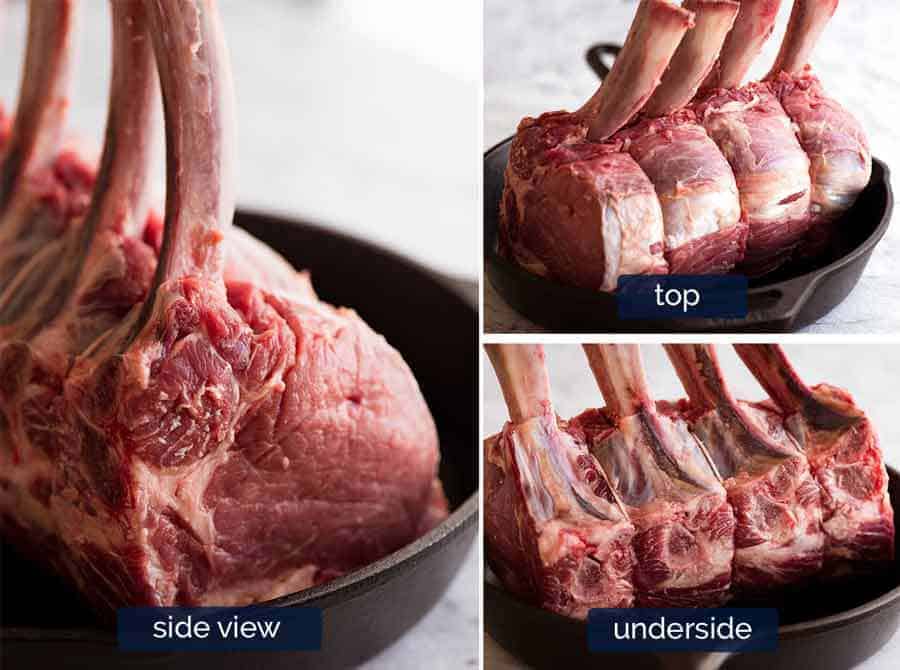
America – If you're in the States, the USDA has made it easy for you by grading prime rib: Prime (the best), followed by Choice then Select. The grading is largely based on the fat marbling and taste.
Here in Australia, we don't have a consistent grading system. But what I can say for sure is that if you want a good quality standing rib roast, skip the supermarket and head to your local butcher. Grass fedorgrain fedcomes down to personal choice.
Grain fedtypically has better marbling and therefore a richer, fattier flavour.Grass fed is usually less fatty but people (me included!) believe the flavour of the beef to be richer, more full of flavour and the meat to be more tender.
If you want top shelf, opt fordry aged beef. You'll pay serious dollars for it – but it's worth it!
The standing rib roast pictured above and below and used in the recipe video has been prepared the standard way we do it here in Australia: the fat cap trimmed and the bones scraped clean for presentation.
The foil: Some butchers will sell the standing rib roast with foil wrapped around the bones. It's to stop the bones from browning, for presentation purposes only. It looks striking to have a dark brown crust, the pink meat and a white bone. If the beef comes with it, I leave it on. But I don't do it myself.
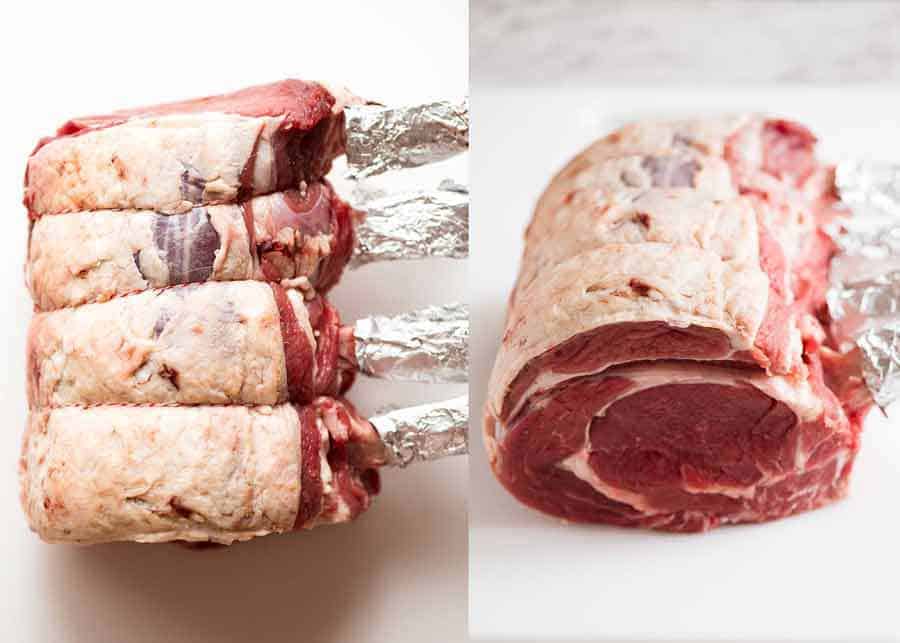
How the beef is cut – Bone in / off / tied back on
This recipe will work fine whether bone in or out, or tied back on. But I'm a firm believer that anything cooked with the bone is juicier, so the thought of roasting a prime rib without the bone never crossed my mind.
Plus – I just think it looksgrand with the bone in! And isn't chewing the meat off the bone the best bit?? 😉
In the States, you'll find some butchers remove the bone then tie it back on. Here in Australia, you'd have to ask for a special order to have the bone cut out.
The meat itself is so incredibly juicy (with the added bonus of the garlic herb butter!), I really doubt you'd notice a difference. So use what you can get, or whatever your personal preference is!
Ingredients you need
When you invest in a good piece of beef, you don't need to do much to it.
But then again, a good slathering of Herb and Garlic Butter certainly doesn't do any harm! 😂
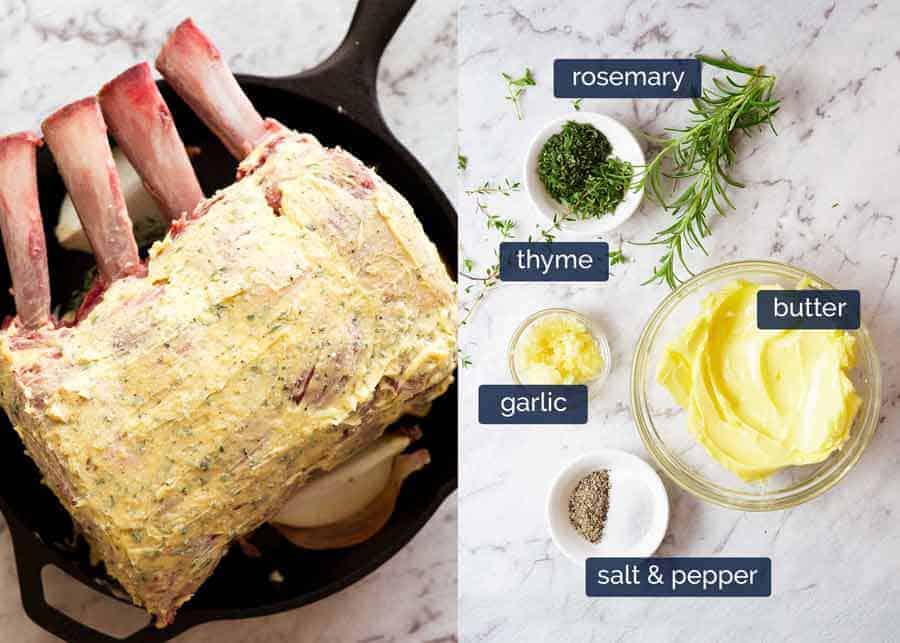
Using softened rather than melted butter works much better because the garlic and herb bits stick to the skin, creating a terrific golden herb and garlic crust!
Feel free to switch the herbs to what you have / prefer. Also, dried herbs work too!
How to make standing rib roast
After slathering the beef with butter, blast it for 20 minutes in a hot oven to get the crust going, then roast in a relatively low oven of 120°C/250°F for a further 1.5 hours before resting for 20 to 30 minutes.
With this method, the high temperature creates a crust quickly, sealing the juices in. Then we turn the temperature down to roast it slowly and evenly so it's blushing pink all the way through, rather than ending up with a thick overcooked band around the outside of the beef.
Target an internal temperature of 50°C/122°F when taking it out of the oven (medium rare, recommended) which will rise to 54°C/129°F after resting for perfect medium rare. See chart below for other doneness.
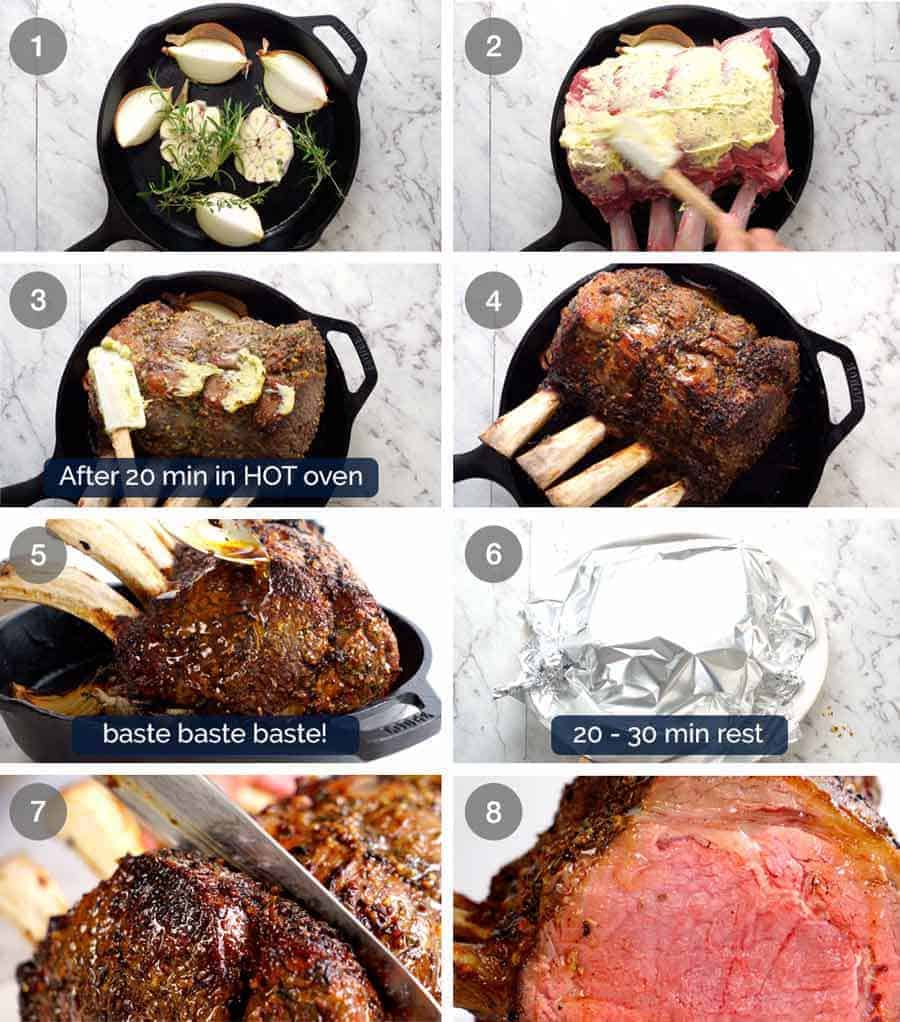
There are recipes "out there" that opt to use an even lower temperature and roast for up to 10 hours. This method cooks the prime rib so slowly that it's evenly pink from edge to edge, then seared at the end to form a thin dark crust.
We actually prefer to have the textural contrast of a thin layer of cooked beef on the outer edge of the beef. It's still 90% pink and cooked to medium rare throughout!
Never skip the 20 minute rest, essential to let the meat juices redistribute. If you don't rest, the meat juice will run everywhere when you slice it = not as juicy.
Target internal temperature
Remember, as I explained at the very top, pull the beef out of the oven before your final Target Temperature as the internal temperature will continue to rise at it rests for 20 minutes. If you pull the beef out of the oven when it is already medium rare (52°C / 125°F), it will be medium after it rests – barely any blushing pink left!
| Doneness | Pull Temp out of oven | Target Temp after rest |
|---|---|---|
| Rare | 48°C/118°F | 51°C/124°F |
| Medium rare (recommended) | 50°C / 122°F | 54°C / 129°F |
| Medium | 53°C/127°F | 57°C / 135°F |
| Medium well done | 54°C / 131°F | 59°C / 138°F |
| Well done | Never! | n/a |
Why I roast on a bed of onion, garlic & herbs
I like to roast my standing rib on a bed of onion, garlic and herbs which serves three purposes:
-
Elevates the beef off the base to encourage more even cooking;
-
Stops the drippings from burning (smokes out oven + can't make a sauce from drippings); and
-
Adds more flavour to the drippings that is then used to make a sauce for the prime rib.
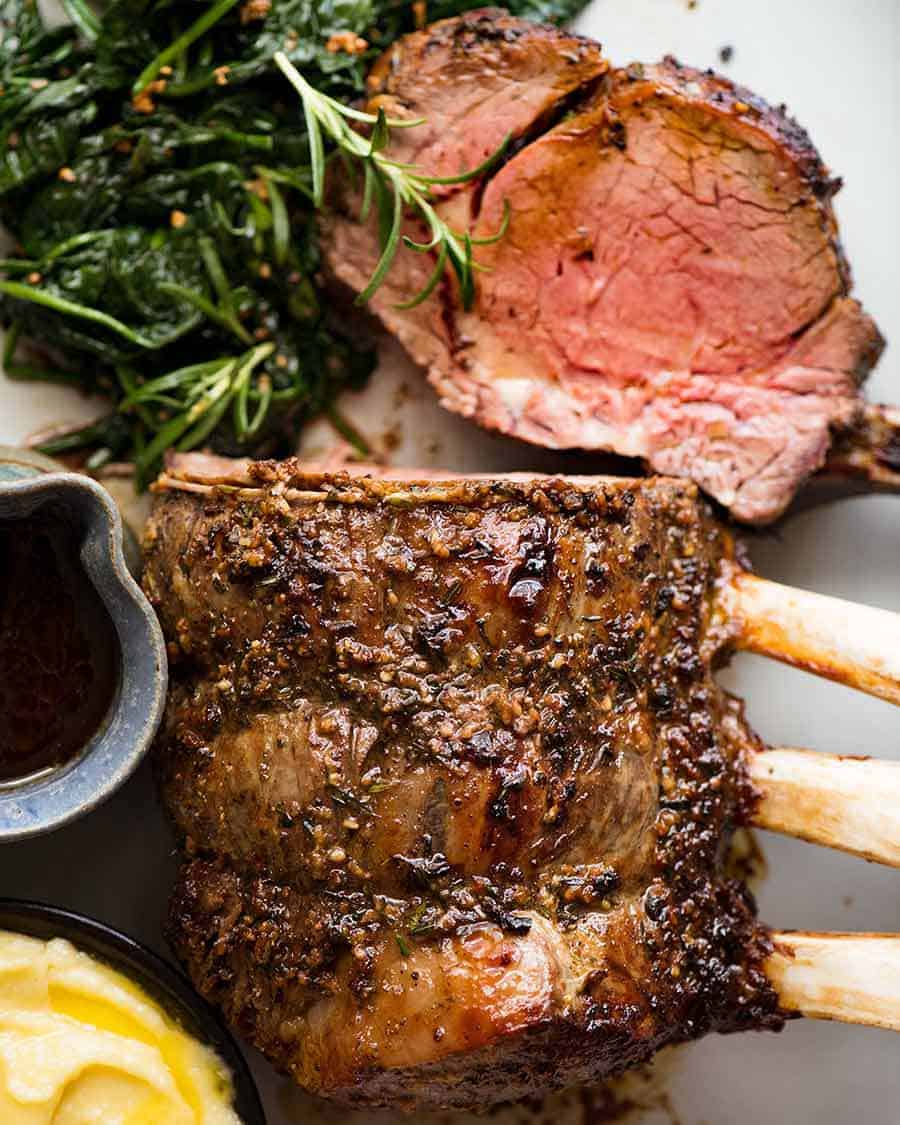
Key tip: take out of fridge 2 hours prior
A standing rib roast is a formidable hunk of meat so to encourage even cooking, I like to take it out of the fridge 2 or even 3 hours prior to cooking.
By reducing the chill in the beef, this prevents the beef from cooking such that you end up with a very thick layer of overcooked beef on the outside and a small circle of pink perfect cooked beef in the middle.
Sauce for Prime Rib – Red Wine Sauce
The drippings from the beef left in the pan are loaded with flavour and begging to be used for a sauce!
Red wine and beef is a classic flavour combination so that's what I've gone with here. Essentially, we're making a red winejus by rapidly simmering beef broth and red wine in the same skillet the beef was roasted in until it reduces down into an intense flavoured, highly savoury sauce.
I like my sauces to have a syrupy consistency so I add a bit of cornflour (cornstarch) to thicken it. But this is optional – most red wine jus are not thickened, they are quite runny sauces.
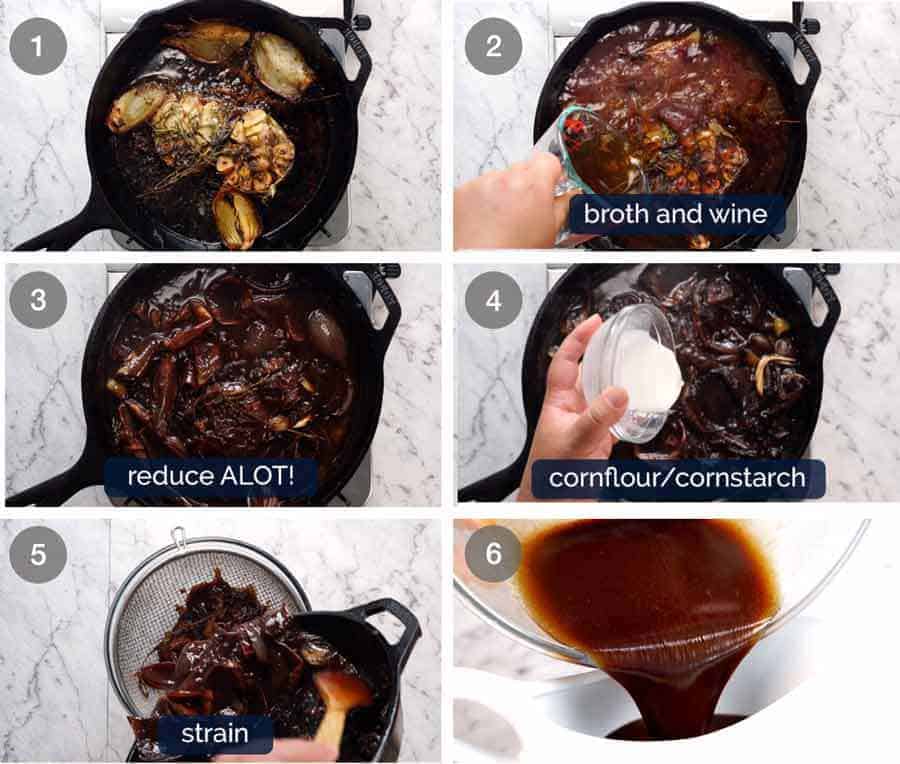
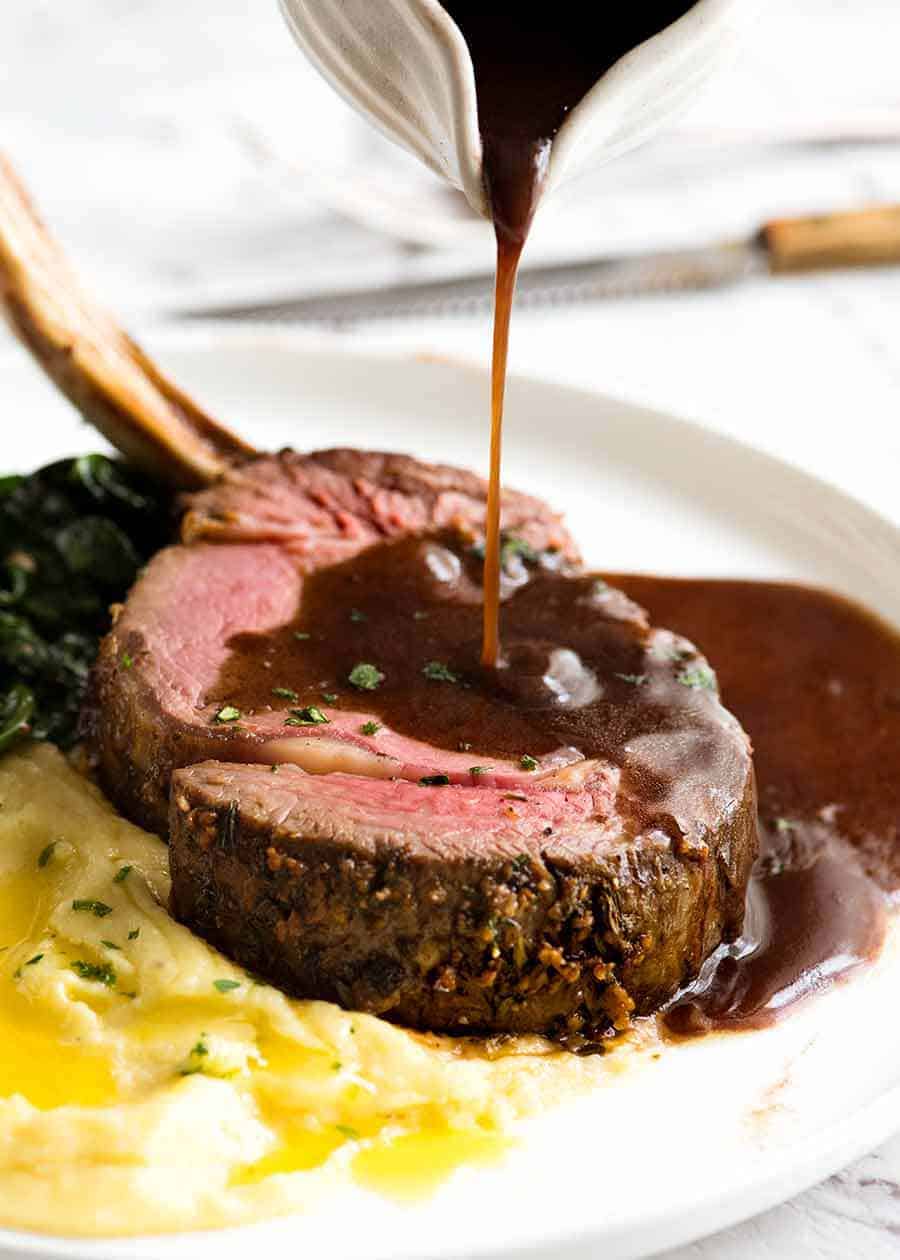
What to serve with Prime Rib
For a high-end restaurant experience, you can't go past Paris Mash(pictured below) – ultra rich and creamy mashed potato! Potatoes au gratin is an elegant French potato side option that's ideal for making ahead. Otherwise, rich and creamy Cauliflower Cheese is a British roast dinner classic! For greens, Garlic Sautéed Spinach pairs exceptionally well with Prime Rib and is a Classic Steakhouse side!
Here are a few more options:
Classic Side Dishes for Standing Rib Roast
Just imagine that moment, when you carve up thick slices of this Standing Rib Roast that's almost impossibly juicy, blushing pink on the inside with that salty, buttery, herb and garlic crust….
It's so unbelievably tender, and it's so perfect you know you could eat the whole thing plain…. But THEN, you add a drizzle of that incredible Red Wine Sauce…..
There. Are. No. Words. It's almost as perfect as a meal gets. – Nagi x
Watch how to make it
Subscribe to my newsletter and follow along on Facebook, Pinterest and Instagram for all of the latest updates.
Servings 6 – 8 people
Tap or hover to scale
Recipe video above. The juiciest, tastiest, BEST roast beef in the world is Prime Rib!! Also known as Standing Rib Roast, this is slathered in a herb and garlic butter, then roasted to juicy perfection. By using a lower but not super low oven temperature, we can be assured of a beautiful even cook throughout the whole roast, yet still have it on the table in a couple of hours. Bonus: lower temp = more forgiving!
Meat thermometer is a MUST!
- 2.5 kg / 5 lb standing rib roast / prime rib , bone in (Note 1)
- 1 onion , unpeeled, quartered (brown, yellow, white)
- 1 head of garlic , unpeeled, halved horizontally
- 5 sprigs thyme
- 3 sprigs rosemary
Garlic Herb Butter:
- 150g/ 10 tbsp unsalted butter , softened
- 5 garlic cloves , minced
- 2 tsp finely chopped fresh rosemary (or 1 tsp dried)
- 2 tsp finely chopped fresh thyme (or 1 tsp dried)
- 2 tsp salt
- 1 tsp black pepper
Red Wine Sauce:
- 1 1/2 cups beef broth/stock , low salt
- 2 1/2 cups dry red wine (Note 2)
- 1 tbsp cornflour/cornstarch (optional, Note 3)
Prepare Beef
-
Bring Beef to room temp: Take beef out of the fridge 2 – 3 hours before cooking to bring to room temp (key tip for even cooking). Pat dry with paper towel.
-
Preheat oven to 240°C/460°F (220°C fan). Adjust shelf so beef will be sitting in the middle of the oven.
-
Garlic Herb Butter: Mix together.
-
Roasting bed: Place onion, garlic and herbs in a heavy based oven proof skillet (or use a roasting pan).
-
Slather 1: Spread a thin layer of butter on the underside of the beef (ie the bone side). Place beef on onion etc, butter side down. Spread about 2/3 of the butter on the top and sides (reserve some for Slather 2).
-
Hot oven: Roast 20 minutes.
-
Slather 2:Remove, spread over remaining butter. Turn oven down to 120°C/250°F (100°C fan).
-
Slow roast: Roast for a further 1 1/2 hours, basting every 30 minutes with the juices in the pan, until the internal temperature is 50°C/122°F in the centre (for medium rare, Note 4). Start checking the internal temp early.
-
Rest:Transfer beef to plate. Cover loosely with foil and rest for 20 – 30 minutes. Internal temperature will rise to 54°C/129°F (which is medium rare).
-
Slice beef and serve with Sauce! For a classic high-end Steakhouse experience, serve with Paris Mash and Garlic Sautéed Spinach.
Red Wine Sauce:
-
Place skillet with onion and garlic left in it on the stove over high heat. Add wine and beef stock, rapidly simmer for 10 minutes until it reduces by 2/3 or so, down to 1 1/2 cups or liquid.
-
Lower heat to medium. Mix cornflour with 2 tbsp water. Drizzle in half and stir. Sauce will thicken in 1 minute or so. Add more cornflour water mixture if you want it thicker.
-
Strain into bowl, pour into sauce jug.
1. Standing Rib Roast – also known as Prime Rib. Use any cut of prime rib – with the bones attached, trimmed and frenched (pictured ie bones scraped clean of meat and excess fat, excess fat mostly trimmed away). OR with bones removed but then reattached by tying it with string, with or without a thick layer of fat. The choice is yours!
Get the best quality you can afford. We don't have standardised quality ratings here in Australia, but if you can, ski the supermarket and opt for your butcher instead. Get a smaller piece of better quality beef, rather than a large piece of lower quality!
In the States, prime rib is graded: Prime is best, then Choice then Select.
Boneless rib eye or scotch fillet roast – this is just Prime Rib minus the bone. Cook per recipe but start checking internal temp 30 minutes earlier, as boneless meat cooks faster.
2. Beef stock/broth – important to use low sodium here otherwise the sauce might end up too salty. If it's too salty, fix as follows: Add 2 to 3 cups of water and 2 potatoes chopped into 2.5cm/1″ pieces (or small enough so they are submerged). Simmer for 10 to 15 minutes – ensure potato doesn't start to break down. Potato will absorb salt. Scoop out potato, reduce sauce again.
3. Wine – Use any red wine that's not sweet or too oaky that's good enough to drink. Shiraz, Cabernet Sauvignon, Merlots are all good options. I always rummage in the discount bins at liquor stores for bargains where you can get good bottles discounted up to 90%!
Win sub: If you cannot drink red wine, skip the wine and just use beef stock to make a terrific beef flavoured garlic-gravy.
4. Internal Temperature of Cooked Prime Rib:The internal temperature will rise by 3 – 4°C / 5 – 7°F while it is resting so it needs to be taken out of the ovenbefore it reaches your desired doneness.
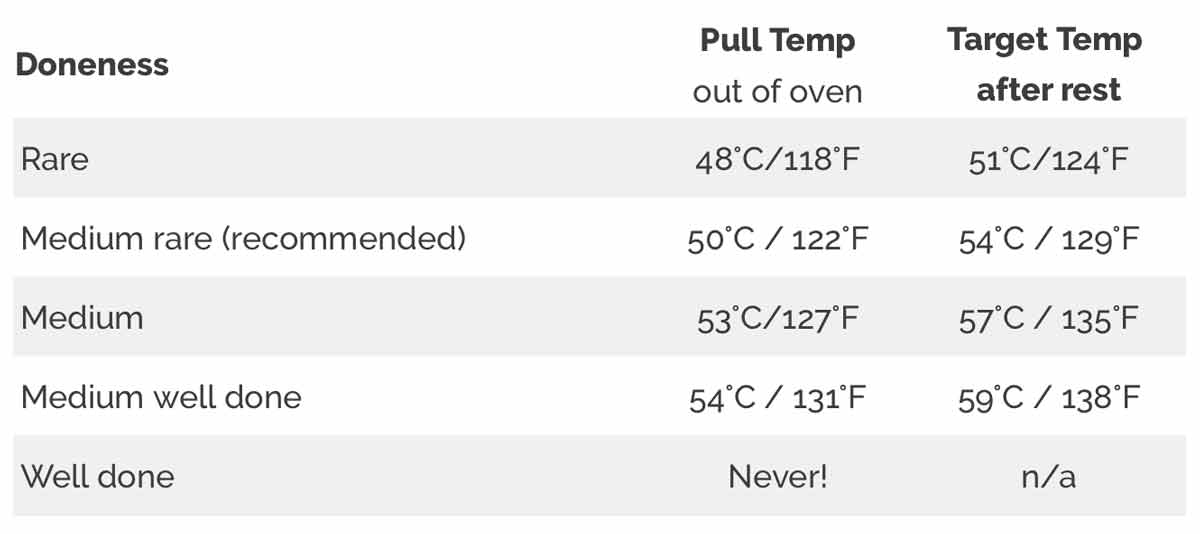
- Pull temp is the temperature at which it should be removed from the oven;
- Target temp is the final temperature of the beef for each level of doneness, to which the beef will rise after resting for 20 minutes.
COOK TIMES for different sizes: Doesn't increase that much with increased size because of the shape. Add 10 -15 minutes for each 1 kg/ 2 lb, but start checking the internal temp early just to be sure.
TIP: Once the internal temp hits 40°C/104°F, the internal temp increases by 5°C/10°F every 10 to 15 minutes.
5. Cornflour/cornstarch is optional. This thickens the sauce slightly to a maple syrup consistency which is how I like it. But this sauce is essentially a Red Wine Jus and they are actually quite runny as they are not thickened in this way. It's a personal preference – so if you don't mind a runnier sauce, you can skip this.
6. Make Ahead: Best made fresh. Keeps warm for 1 hour and can be blasted in hot oven for a few minutes to freshen up the crust. For leftovers, I like to keep it whole then slice thinly. Microwave very gently until just warmed (and still pink!). Or slice thinly, bring to room temp, pile of rye bread with mustard and pickles and make the BEST Roast Beef Sandwich EVER!
7. Unpeeled onion and garlic: I leave them unpeeled because then they hold together better so they keep the prime rib elevated off the base of the skillet. Unpeeled onion collapses into a soft pile very quickly. The onion is strained out later when making the sauce.
8. Nutrition per serving. Calculated using an estimation of the bone weight, and assuming most of the fat is trimmed. Includes sauce.
Calories: 671 cal (34%) Carbohydrates: 2 g (1%) Protein: 64 g (128%) Fat: 44 g (68%) Saturated Fat: 19 g (119%) Cholesterol: 193 mg (64%) Sodium: 941 mg (41%) Potassium: 885 mg (25%) Vitamin A: 85 IU (2%) Vitamin C: 3.5 mg (4%) Calcium: 34 mg (3%) Iron: 5.7 mg (32%)
Originally published 30 November 2018. Post reviewed regularly and updated if necessary. Last updated December 2021. No change to recipe – this is a master recipe loved by many so I wouldn't dare!
Best of Sunday Supper Roasts
For fellow roast lovers….
Life of Dozer
Is it juicy Dozer??? Is it???
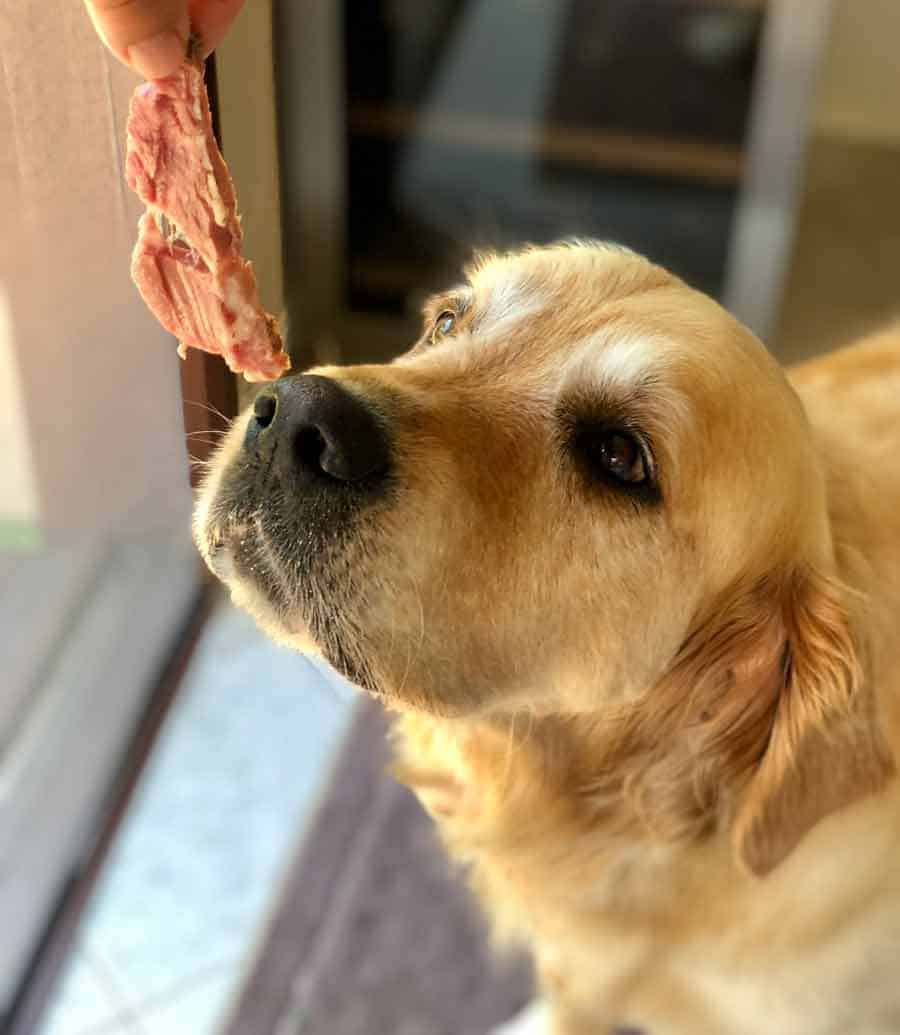
Source: https://www.recipetineats.com/standing-rib-roast/
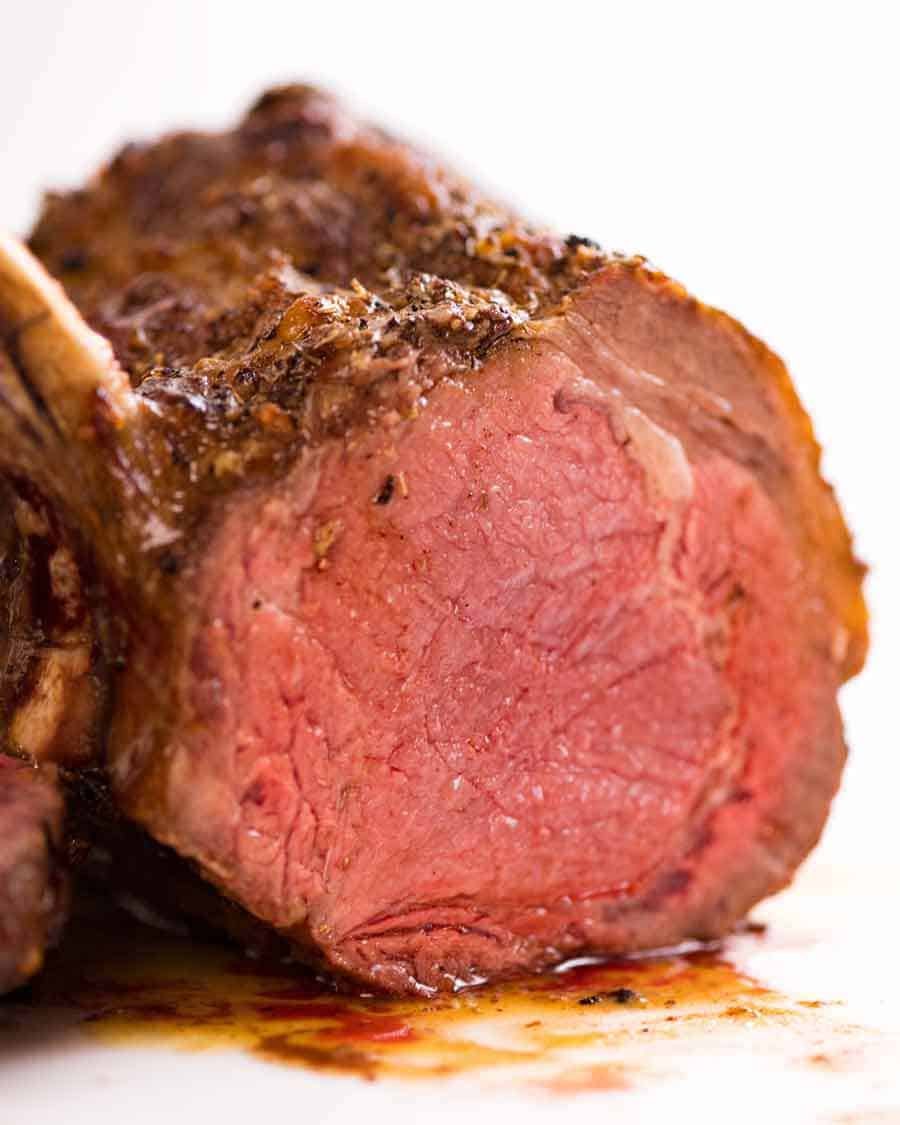
0 Response to "Roasting Bone in Rib of Beef"
Post a Comment